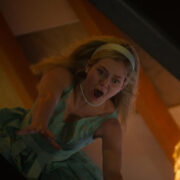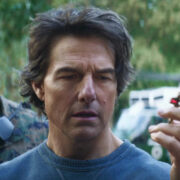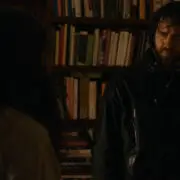BOB LAZAR: AREA 51 & FLYING SAUCERS: One Small Step For Man, One Giant Leap To Conclusions

Tom is a recent graduate based in the UK, who…
Bob Lazar: Area 51 & Flying Saucers examines a contentious figure in a partial and questionable way – but its strange style and low-tech style is where it really lets itself down.
In 1989, Bob Lazar “came out” to the world as a scientist working near a top-secret research base near Area 51, claiming he worked with alien technology that the US Government was hiding from citizens. He’s since become an idol for UFO buffs and conspiracy theorists, and is credited with popularising myths of Area 51 as a UFO hotspot.
There’s a lot of baggage to the man, including evidence he lied about his education, his roles in a prostitution ring, and lawsuits for illegally smuggling banned chemicals. A fair and honest documentary about him would be a fascinating story – how many people can create a popular myth, become chemical smugglers, aid a prostitution ring, and claim the government is hiding secret alien technology?
However, Bob Lazar: Area 51 & Flying Saucers is far from a fair or honest documentary. A project by Jeremy Kenyon Lockyer Corbell, it’s part of a series on “Extraordinary Beliefs”. While it can’t quite be accused of being a crazy conspiracy video, it barely questions Lazar’s beliefs, and spends hardly any time depicting him as opposed to trying to “explore” the government’s “oppression” of the man. On top of that, it was made in such a bizarre and low-quality style, that it feels more like an endurance event than an enlightening debate.
Trying to Alienate an Audience
When you’re being taught how to film a documentary there are certain things you’re taught as immutable rules: film enough b-roll to accompany your dialogue, frame the interviews correctly, make sure the audio capture of these interviews is as high-quality as possible. Bob Lazar: Area 51 & Flying Saucers throws these rules out the window.

Many of the interviews (although, admittedly, not all of them) are filmed and edited in a strange style in which radically different angles are used, but the subject is facing the camera each time. While multi-camera interviews are sometimes acceptable, in order to vary footage, this style of shooting openly draws attention to the edited and artificial nature of the interview. It’s also hugely jarring to watch, and can be disorientating when multiple distinct shots are inter-cut in quick succession.
One particular example exists in which Lazar has promised to reveal a secret, and the presenter proceeds to promise that the visual and audio footage would be encrypted and hidden away so it couldn’t be edited by anyone. What follows is a hyper-speed quick cut of Lazar talking and gesticulating, followed by different cuts of the conversation and ominous music playing underneath. After Corbell promised the footage wouldn’t be edited, it is in such a blatant and extreme way that any illusion of fact is shattered.
In addition, the audio capture is terrible. In one particular instance, TV reporter George Knapp is being interviewed while in a room with a swimming pool (for some reason). The sheer noise of echo from the huge room, and the pool, makes it hard to hear what he’s saying, which again distracts from what he’s actually trying to say. Other interviews have this issue to a lesser extent, with copious amounts of background noise or strange music present.
Other issues plague the production quality of the documentary. There’s an over reliance on CGI diagrams and dioramas as b-roll, and that’s when the background footage to audio clips isn’t just irrelevant and strange stock footage or special effects. There’s no discernible chronology or order to the topics, so many ideas are constantly revisited or barely considered at all, and too much time in interviews is taken up with subjects fiddling or fidgeting as they think or before questions – a tactic which can humanize in small doses, but just wastes time to such an extent.

However the most insufferable element of the documentary, more than indiscernible audio or flagrant disregard to documentary rules, is occasional narration from Mickey Rourke. His sporadic addresses don’t deal with the topic at hand, but instead spew nonsensical and pseudo-profound spiels on theology, sociology, existentialism and other related topics. When you can even make out what he’s saying, it’s easy to grow infuriated at the juvenile takes on a wide range of philosophical ideas – and they’re not even relevant to the documentary at all!
Taking Pseudoscience for Granted
Of course a documentary exploring Bob Lazar is going to have some kind of angle, but Bob Lazar: Area 51 & Flying Saucers doesn’t go far enough to explore or challenge his comments, and instead takes for granted the “reliability” of the word of him and his friends.
To his credit, early on Corbell brings up and describes the various challenges to Lazar’s authenticity and character, including a lack of proof as to his education and his various criminal activities. However some of the logic used to “disprove” these marks on his record is markedly flawed – Lazar’s assertion that “I got hired by a laboratory so I must have had the degree from MIT” is left without comment, and the raids into his illegal chemical shipping is presented as a conspiracy to cover up materials he stole from his alien research.
This speaks to a larger issue with the documentary – it barely questions Lazar’s records or accounts of his tale, and instead takes for granted the legitimacy of its main character. This is a fatal flaw for any kind of authenticity or reliability the film can have, and totally alienates any audience that doesn’t believe the US government has secretly been harboring aliens and alien technology for 50-odd years. This critical audience is even mocked early on in the film, when Rourke says (and this is word-for-word) “not to burst your bubble, but the Earth is not the center of the universe”. People who disagree with the conclusions of the documentary are portrayed as anti-scientific idiots, which does little to endear them to the arguments made.

It’s a little rich then that later “proof” of the science of the alien spaceships is treated about as scientifically as the resolution to a Star Trek story. When Lazar is drawing diagrams of alien space ships and force fields, random scientific buzzwords and phrases are thrown around with such reckless aplomb that even he admits “this makes no sense”.
The Man Underneath the Tin Foil Hat
At its core Bob Lazar: Area 51 & Flying Saucers has an interesting narrative, although it refuses to recognize it.
Lazar is a tragic figure – he admits regret at his past actions regarding UFOs, and it’s clear he just wants to get on with a normal life. The documentary successfully gives an insight into his life – you get a sense of who he is and what makes him tick, including his passions, hobbies, and joys. In a way he’s even endearing, and seems truly tortured by the route his life has taken since 1989.
However the documentary doesn’t seem to recognize this human drama playing out, and instead uses his conflict as a glorified kind of character witness to “prove” the legitimacy of his nearly thirty-year-old claims. There isn’t enough of a historical insight into his life outside of his actions – we barely find anything out about his childhood, his personal life during his Area 51 debacle (that must have had huge implications for him and his family!), or his progression from scientific whistle-blower to chemistry company owner.
It’s a shame, because the brief glimpses shown of these periods of his life, of him living under the shadow of his reputation, seem far more interesting than the standard UFO/conspiracy/alien technology/government cover-up trite.
Bob Lazar: Area 51 & Flying Saucers: Conclusion
Poor direction doesn’t necessarily ruin a documentary, nor does a slight wonky aim, and crazy pseudoscience can sometimes make for highly entertaining documentaries. However Bob Lazar: Area 51 & Flying Saucers sits at the center of that Venn diagram – which is a shame, because there are brief moments where the veneer shatters and a truly captivating story is shown.
To be fair to Corbell, there are a few good aspects of the film. Some of the establishing shots are well-filmed, he’s very passionate about the topic, and he clearly has great rapport with the interview subjects – he jokes with Lazar’s mother, and it’s one of the great moments where the man is presented as a simple human. He seems affable enough – but that’s not enough to save a troubled documentary such as this.
It’s a pretty damning statement to say, but the fact the documentary takes for face value the fact that UFOs exist is the least of its problems – the poor quality filming and missed opportunity for the story do far more damage at derailing the narrative.
Is it possible to make a documentary about a man such as Lazar without engaging in the events he was involved in? Tell us your thoughts in the comments below!
Watch Bob Lazar: Area 51 & Flying Saucers
Does content like this matter to you?
Become a Member and support film journalism. Unlock access to all of Film Inquiry`s great articles. Join a community of like-minded readers who are passionate about cinema - get access to our private members Network, give back to independent filmmakers, and more.
Tom is a recent graduate based in the UK, who writes about films and games, and makes a few of his own. If he's not watching a film, playing a game or writing a script - don't worry! - he's probably just gone to make a cup of tea. He's never far from a screen.













